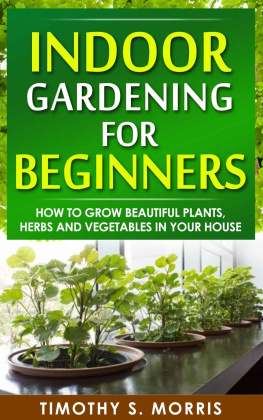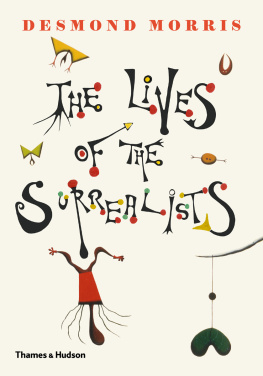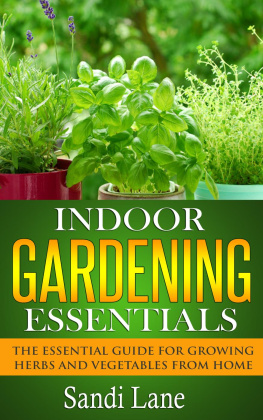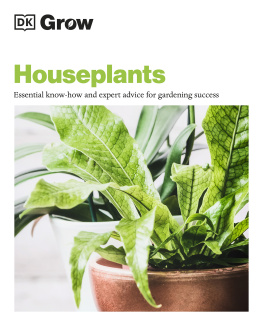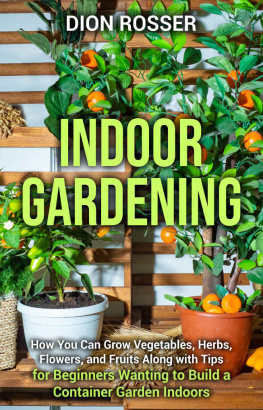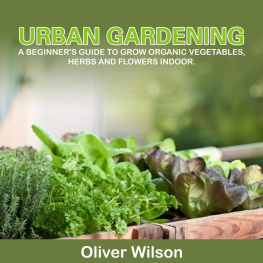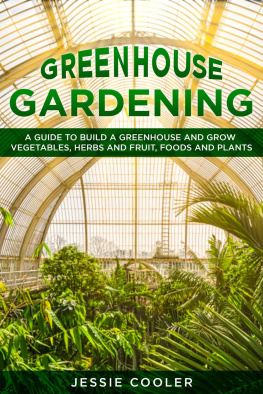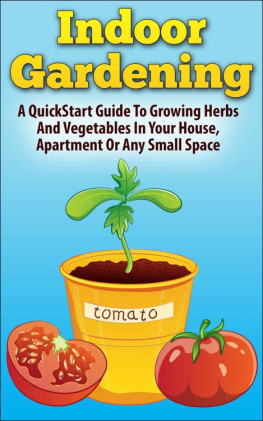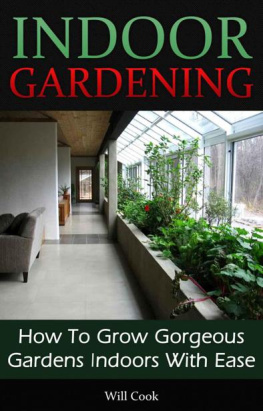Morris - Indoor gardening for beginners : how to grow beautiful plants, herbs and vegetables in your house
Here you can read online Morris - Indoor gardening for beginners : how to grow beautiful plants, herbs and vegetables in your house full text of the book (entire story) in english for free. Download pdf and epub, get meaning, cover and reviews about this ebook. year: 2015, publisher: [CreateSpace], genre: Children. Description of the work, (preface) as well as reviews are available. Best literature library LitArk.com created for fans of good reading and offers a wide selection of genres:
Romance novel
Science fiction
Adventure
Detective
Science
History
Home and family
Prose
Art
Politics
Computer
Non-fiction
Religion
Business
Children
Humor
Choose a favorite category and find really read worthwhile books. Enjoy immersion in the world of imagination, feel the emotions of the characters or learn something new for yourself, make an fascinating discovery.
Indoor gardening for beginners : how to grow beautiful plants, herbs and vegetables in your house: summary, description and annotation
We offer to read an annotation, description, summary or preface (depends on what the author of the book "Indoor gardening for beginners : how to grow beautiful plants, herbs and vegetables in your house" wrote himself). If you haven't found the necessary information about the book — write in the comments, we will try to find it.
Indoor gardening for beginners : how to grow beautiful plants, herbs and vegetables in your house — read online for free the complete book (whole text) full work
Below is the text of the book, divided by pages. System saving the place of the last page read, allows you to conveniently read the book "Indoor gardening for beginners : how to grow beautiful plants, herbs and vegetables in your house" online for free, without having to search again every time where you left off. Put a bookmark, and you can go to the page where you finished reading at any time.
Font size:
Interval:
Bookmark:
Indoor Gardening for Beginners
How to Grow Beautiful Plants, Herbs and Vegetables in your House
Timothy S. Morris
http://www.timothymorrisbooks.com
All Rights Reserved. No part of this publication may be reproduced in any form or by any means, including scanning, photocopying, or otherwise without prior written permission of the copyright holder. Copyright 2014
Table of Contents
Chapter Eight: Making a Miniature Ecosystem
It Doesnt Matter Where You Live...You Can Start a Garden Right Now
Gardening usually stirs up thoughts of large outdoor setups complete with irrigation systems, fences to keep animals out and row upon row of produce growing in soil perfectly cultivated to provide maximum crop yields.
Gardens like this are still very popular around the world and are an excellent way to become more self-sufficient by growing your own fresh fruits and vegetables at home.
Unfortunately, traditional outdoor gardens also presents a few drawbacks. They take up a lot of space and the growing season can vary by months depending on the region.
For years, I lived in a small apartment without access to land to grow my own food. Everything I ate was purchased at the store sometimes from questionable sources and often treated with harmful chemicals to increase shelf life. That was, of course, until I learned how to maximize the space all around me. That is to say, the indoor space inside my very own apartment.
But growing food indoors isnt just for apartment dwellers. By growing indoors, you effectively extend the growing season by months. In fact, when properly set up, most indoor gardens can be cultivated year-round. Try doing that outside in the winter months!
Even if you already have an outdoor garden, you should still consider starting some plants indoors. Not only does this allow you to increase annual crop yields, but it may also give you the opportunity to try growing new fruits and vegetables that might not grow in an outdoor environment (depending on where you live).
Basically, the benefits of indoor gardening are:
Ease and low-cost associated with getting started
Takes up very little space in the home
Extends the growing season and even allows for year-round crop production
Did I mention how easy indoor gardening is?
Even if you have never planted a single crop in your life, Im going to teach you how to grow beautiful and nutritious fruit and vegetable plants in the comfort of your own home or apartment. Dont think you have enough space? Or enough time to tend the garden?
Sorry to be so blunt, but youre wrong. This book teaches you how to grow your own food using innovative space-saving techniques that, once properly set up, need very little care on a daily basis.
You can do this and this book was specifically designed to give you the knowledge required for instant success.
So, without further ado, lets start a garden!
Chapter One: Planning for Success
Like most things in life, we need to take time when planning our garden to ensure optimal results. Dont worry though, its really not that difficult.
To properly plan out an indoor garden, keep in mind:
Location
Growing method(s)
Availability of natural light
Airflow
Temperature
Now, lets take a look at each of these considerations in more detail.
The whole point of indoor gardening is to maximize available space using a variety of growing methods. This is great news because it means we dont need to devote an entire room to gardening (although you certainly can).
Your indoor garden can go anywhere you want thats the beauty of it. That said, there are few things to consider. How much food you want to grow dictates how much space you should devote to the garden.
A small herb garden is right at home on a window sill in most cases, but larger vegetable plants are better placed in a container where they have enough room to grow. We need to keep the vertical space required by each plant in mind as well as the size of the root system under the soil. This is especially true for root vegetables.
Perhaps one of the greatest challenges when gardening indoors is ensuring your plants receive the correct amount of light every day. In a traditional outdoor garden, the sun provides up to 12 - 18 hours of sunlight each day during the summer months and many plants, like tomatoes, require lots and lots of sunlight to yield edible food.
The problem, of course, is that the sun moves throughout the day so the likelihood of exposing your plants to enough natural light indoors is slim. All hope isnt lost, however, because if we remember that the sun spends most of the day in the southern sky, we can maximize our plants access to natural light by placing them near southern facing windows.
Especially when combined with plant species not requiring a lot of sunlight, you may be able to rely on the suns natural light for most of the year. In the winter, the sun is much lower on the horizon which could prevent some plants from thriving indoors during the off-season.
If you plan to use natural light, find a large southern facing window where the garden can be kept. Also keep in mind any obstacles that could obstruct sunlight during the day (buildings, trees, etc.). By observing the pattern of the sun for a day or two, you should be able to pick out the best spot pretty easily.
Unfortunately for many of us, there isnt enough natural light to support many of the common plant species we want to grow. This means we need to add artificial lighting to supplement the needs of our garden. Were going to talk about artificial grow lights in Chapter Three.
Plants survive by converting carbon dioxide in the atmosphere into oxygen. To ensure the garden always has access to carbon dioxide, we need to make sure the are we choose for our garden has sufficient airflow.
If the garden is located in a large, centralized area of the home you really dont have to worry about airflow. There should be plenty. If, on the other hand, the garden is located in a closet or in some other out-of-the-way place, improper airflow is a concern.
The easiest way to overcome this is to add a fan. A simple box fan for the local big-box store is sufficient to move air over even large indoor gardening setups. Just be careful not to turn up the fan too high as this will damage many plants. A slow, gentle breeze is all thats required for optimal airflow.
Most plants are picky when it comes to temperature. Although most species can tolerate slight dips in temperature (like those experienced at night in outdoor gardens), continuous exposure to temperatures that are either too hot or too cold will kill your plants or, at the very least, adversely affect crop yield.
Indoor gardening almost completely eliminates concerns about temperature from the equation because Im assuming the inside temperature of your home remains relatively consistent.
There are a couple of temperature-related considerations that do affect indoor gardens.
Avoid putting your garden near objects that get extraordinarily hot (or cold for that matter). The oven, heaters and the air conditioner are all potential enemies of your plants.
Also keep your garden away from drafty windows and doors in the winter months. Constant bursts of cold air could stunt the growth of plants and significantly reduce yields.
One of the best parts about indoor gardening is just how many more options we have compared to traditional outdoor gardening techniques. These techniques are easy-to-use, versatile and greatly increase your chances of success the first time around.
Font size:
Interval:
Bookmark:
Similar books «Indoor gardening for beginners : how to grow beautiful plants, herbs and vegetables in your house»
Look at similar books to Indoor gardening for beginners : how to grow beautiful plants, herbs and vegetables in your house. We have selected literature similar in name and meaning in the hope of providing readers with more options to find new, interesting, not yet read works.
Discussion, reviews of the book Indoor gardening for beginners : how to grow beautiful plants, herbs and vegetables in your house and just readers' own opinions. Leave your comments, write what you think about the work, its meaning or the main characters. Specify what exactly you liked and what you didn't like, and why you think so.

